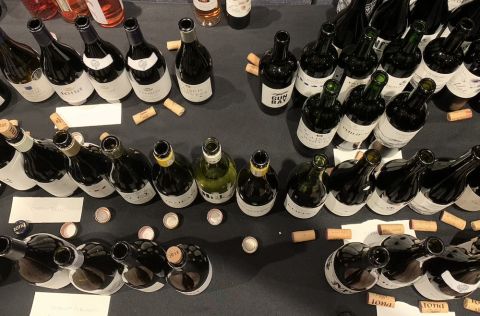- Oldenburg, <CL° 2019 Stellenbosch from 120 rand, €10.85, £13.95 – find this wine
- Beaumont, Hope Marguerite Chenin Blanc 2018 Bot River from 321.74 rand, €21.95, 24.50 Swiss francs, $29.19, £27.95 – find this wine
- Mulderbosch, Single Vineyard Block W Chenin Blanc 2017 Western Cape from 275 rand, £23, 249 Swedish kronor, €36 – find this wine
I've written before about whether wine itself can be a force for good. Today, we all have an unequivocal opportunity to do a good thing: buy South African wine.
Many wine regions around the world face hardships. Earlier this year, devastating Australian bushfires mobilised us to put our pounds where our palate is. Since then, the pandemic has wreaked havoc on the wine industry worldwide, but none has suffered more than South Africa, which is currently enduring a second blanket ban on all sales of alcoholic drink across the country.
But even without a charitable angle, the current South African wine scene has many reasons to claim our affection. Quality has never been better, thanks in no small part to the New Wave movement, which has proved so beloved by the British wine trade. At a recent tasting of Cape wines in Singapore (held by an ambitious retailer who plans to open his first premises here this year), I was reminded of that excitement, as well as the wines' absolutely outstanding value. Furthermore, South Africa is one of only two places that specialises in world-class Chenin Blanc.
Which brings me to my wines of the week trio, all of which stood out as superb examples of the variety, and all of which I scored 17 out of 20. As a new cuvée since the 2018 vintage, the Oldenberg <CL° is new to our tasting-notes database, but the other two have previously scored highly over the years.
Beaumont's Hope Marguerite is a long-standing favourite among Chenin lovers. First produced in the 1997 vintage, from vines planted in the 1970s, it is vinified in 400-litre French oak barrels (15% new) using ambient yeast, then kept on the lees for ten months, which explains the fleshiness I enjoyed in the 2018 bottling. Malolactic conversion is blocked, leaving behind super-tangy acidity. The alcohol is 12.47% (although the label states 13%), and it finishes bone dry.
This very powerful structure, alongside excellent fruit concentration, makes this wine strongly reminiscent of the great Loire Chenins of Anjou. The 2018 vintage is available in the UK, US, Europe and Japan and is a wine to buy now and cellar for up to ten years.
Block W is one of three single-vineyard Chenin Blancs made by Mulderbosch, from a granitic site south of Stellenbosch and close to False Bay. Other than the size of vessel (Mulderbosch choose 1,500-litre foudres for fermentation and maturation), the winemaking and analysis are very similar to those of the Hope Marguerite, yet the result is appreciably different.
There is a creamier texture here, with riper apple fruit. With its nutty complexity and pale golden colour, there is also a suggestion of either slight oxidation or botrytis influence (or both, since they often go together), which combine brilliantly with the fresh acidity and bitter finish.
Finally, Oldenburg's awkwardly named <CL° white is a blend of 75% Chenin Blanc with 25% Chardonnay. The name is a reference to their climate, according to the tech sheet: '<CL° is the concept range in the Oldenburg Vineyards stable. A concept means the representation of an idea. For us, the <CL° range represents a key part of our story: that we are cooler than Stellenbosch (in terms of climate).'
This is a reference to the fact that Oldenburg are based in the Banghoek Valley, east of the town of Stellenbosch, which is cooler than much of the rest of the Stellenbosch region thanks to the influence of mountain ranges, elevation and winds.
Whatever the name means, it is not obviously pronounceable, which is never a good thing for restaurant wine lists. With 14% alcohol, this is a weightier style than the other two, but it is also fermented in stainless steel, with 40% remaining unoaked throughout maturation. Accordingly, there is plenty of upfront baked-apple fruit flavour, as well as the delicious honey character typical of the variety – although again, the finish is bone dry.
This is the best value of the three Chenins, but with least availability, although UK buyers can currently snap it up for under £15.
All three of these bottles demonstrate how sophisticated, diverse and delicious South African Chenin Blanc can be. Not only do they taste good, but by buying them now, you will be doing good for an industry in dire need of our support.


















